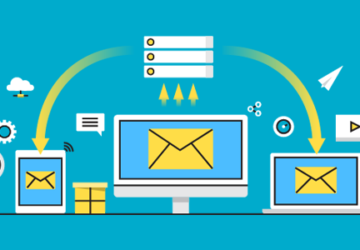Ever since the first industrial revolution, man has tried to shape his environment and overcome the physical limitations we are born with. After all, it is in our human nature to strive to evolve and achieve progress, and healthcare makes no exception. Nowadays, using various digital tools and software-enabled services to our advantage, and some experts even define new generations are techno sapiens, a brand new species.
Working in a bespoke software development company with experience in healthcare and medical software development, I see how beneficial technology advancements are for modern-day humans. Just recently, researchers of Stanford University and the Technical University of Munich developed explainable artificial intelligence (AI) to decode the deeper regulatory code of the human genome. Although we are one step closer to unravelling the mysteries of biology and medicine and harnessing this knowledge to design better digital healthcare, the history of healthcare software begins modestly with far simple solutions.
In this article, we follow the timeline of healthcare software evolution with major disrupting technologies and innovations.
- The Emergence of E-Health
E-Health is short for Electronic Health and encompasses the use of electronic and tech devices as part of routine healthcare services. Dependent on the innovative inventions in the fields of computer science and information technology, the E-Health history can be traced back to the first use of teleradiology, telepharmacology and hospital-based telemedicine in the 1960s. Some evidence suggested that high-quality stroke exams and monitoring of intensive care patients were among the benefits of remote healthcare.
Fast forward to the present day and rising concerns about the next Covid-19 wave in the fall. It was thanks to digital technology that hospitals and general healthcare providers could offload some of their patient flow in 2020. Moreover, telemedical services are on their way to becoming a standard healthcare delivery alternative after they proved to be a cost-effective and reliable option. In fact, in some countries such as France, the UK and Germany, national law regulations permit regular reimbursements for patients.
- The Evolution of Electronic Health Records
EHR (Electronic Health Record) systems are without a doubt one of the most widespread types of healthcare software used by healthcare providers. Essentially, it is digital data-storing and data-sharing software that took over the previous documentation method of paper file organisation. Lockheed was a pioneer in digitalising clinical patient records in the 1970s. The solution included many of today’s know EHR elements such as current anamnesis, physical examinations, lab results and treatments summaries.
After this, the 90s produced fruitful discussions regarding the necessity of EHR implementation on a national level in the USA. Back then, the computer systems were called CPRs (Computer-based Patient Records) and targeted to solve data availability and easy access issues for physicians. Nowadays, we can hardly imagine a medical practice without integrated EHR software. With innovative trends such as personalised and patient-centred medicine, it’s no surprise that future developments will dive deeper into Big Data, NLP and AI utilisation, and custom pharma software will play a crucial role in that.
- Online Medical Database Sources
Almost each of us has an online symptoms checker to rule out certain diseases or has browsed through the unlimited healthcare-related articles out there. It’s amazing that today’s patients have the privilege of abundant information accessibility. However, one downside of this democratisation of knowledge sharing is that online sources are not always credible and trustworthy and can sometimes cause more damage than good (e.g. wrong diagnosis or delayed treatment).
A common solution to solve this problem are medical database software to boost general health literacy among the community and give doctors access to up-to-date medical knowledge. An immediate benefit is that healthcare professionals can perform cross-references, compare current patient cases with similar cases and give precise diagnoses. Moreover, doctors can use this database software as further educational opportunities to become more knowledgeable professionals.
- Medical Imaging Software
There are many available medical imaging software solutions on the market. Some of the key areas that these include are digital image exchange, distributed image repository and business intelligence. Going back to early developmental stages, lots of well-deserved significance is attributed to the inventions of computer tomography (CT) and magnetic resonance imaging (MRI) in the 20th century. Given that today’s technologies, e.g. AI and cloud-based image analysis, allows even more accurate visual representation of diseases, it all brings diagnostics to a whole next level.
But let’s also keep in mind that disruptive trends that promise to stay even after the pandemic, such as telemedicine and personalised healthcare, are also influencing software development. For example, some of the most innovation-driven healthcare providers already utilise custom software as a strategy to boost patient engagement. Thus, shifting patients’ perceptions and leaning towards the fact that they are not just service receivers is a necessary next step. 21st-century patients should be urged to be proactive individuals as their decisions directly influence the treatment outcome.
- mHealth and What it Has to Offer
Mobile Health or mHealth is the most recent healthcare software type on the market landscape. Most of the younger generations, such as Millenials or Gen Zs, are naturally inclined to using technology as an integral part of their daily activities. Therefore, mHealth is most popular among this age group as they utilise their digital devices such as smartphones and tablets beyond simply calling and texting.
Another reason is that mHealth is becoming more and more popular are the rising costs in healthcare and prevention-aware patients. Many mHealth apps include wellness or fitness tracking options via wearable devices or even a direct connection to the primary healthcare provider within a few clicks. According to expert predictions, this market is going to reach $189bn, so that there are many great opportunities both for established and emerging digital health businesses.
Author Biography Aleksandrina Vasileva
Aleksandrina is a Content Creator at Dreamix, a custom software development company, and is keen оn innovative technological solutions with a positive impact on our world. Her teaching background, mixed with interests in psychology, drives her to share knowledge. She is an avid reader and an enthusiastic blogger, always looking for the next inspiration.







